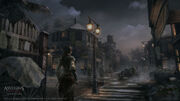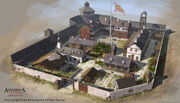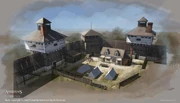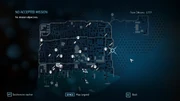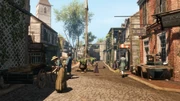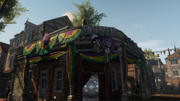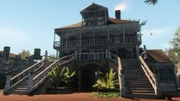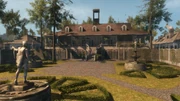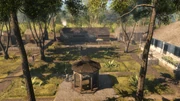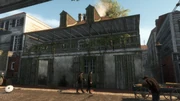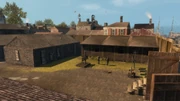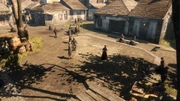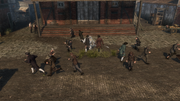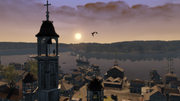(→Eliminating the Templars: Balls.) |
mNo edit summary |
||
| (37 intermediate revisions by 13 users not shown) | |||
| Line 1: | Line 1: | ||
| − | {{Era| |
+ | {{Era|Locations}} |
{{WP-REAL}} |
{{WP-REAL}} |
||
| + | {{Dialogue|Gérald|The Spanish are... sympathetic to our aims now. New laws may... ease your efforts to help the slaves.|Aveline|Could it be that for the first time, home holds more comfort than conflict?|[[Gérald Blanc|Gérald]] and Aveline on New Orleans, 1771.|Assassin's Creed III: Liberation}} |
||
{{Location Infobox |
{{Location Infobox |
||
|image = AC3L New Orleans overlook.png |
|image = AC3L New Orleans overlook.png |
||
| − | |state = |
+ | |state = [[United States]] |
| − | |rulers = |
+ | |rulers = [[Kingdom of France]] <small>(1718 – 1763)</small><br>[[Spanish Empire]] <small>(1763 – 1801)</small><br>First French Republic <small>(1801 – 1803)</small> |
|factions = [[Templars]]<br>[[Assassins]] |
|factions = [[Templars]]<br>[[Assassins]] |
||
|founded = {{Wiki|Mississippi Company|Company of the West}} |
|founded = {{Wiki|Mississippi Company|Company of the West}} |
||
|date = 1718 |
|date = 1718 |
||
| − | |landmark = [[Saint Louis Cathedral]]<br>[[Place d'Armes]]<br>[[Congo Square]]<br>[[Madame John's Legacy]] |
+ | |landmark = [[Saint Louis Cathedral]]<br>[[Ursuline Convent]]<br>[[Place d'Armes]]<br>[[Congo Square]]<br>[[Madame John's Legacy]] |
|targets = [[Jean-Jacques Blaise d'Abbadie]]<br>[[Antonio de Ulloa]]<br>[[Diego Vázquez]]<br>[[Madeleine de L'Isle]]}} |
|targets = [[Jean-Jacques Blaise d'Abbadie]]<br>[[Antonio de Ulloa]]<br>[[Diego Vázquez]]<br>[[Madeleine de L'Isle]]}} |
||
| − | '''New Orleans''' (French: ''La Nouvelle-Orléans'') is |
+ | '''New Orleans''' (French: ''La Nouvelle-Orléans'') is the largest city located in southeastern [[Louisiana]], straddling the {{Wiki|Mississippi River}}. |
| + | |||
| + | Due to its prominent position in trade, New Orleans quickly became a major economic, political and cultural center. Although [[France|French]] in origin, the city would change hands a number of times throughout history. |
||
==History== |
==History== |
||
===French roots=== |
===French roots=== |
||
| − | Before |
+ | Before French explorers and traders arrived in the 1690s, indigenous populations inhabited the grounds upon which New Orleans would be built; the city was founded on May 7, 1718 by the {{Wiki|Mississippi Company|Company of the West}}. [[Slavery]] was prevalent even in the city's early days, being a significant component of New Orleans' complex and diversified society.<ref name="Encyclopedia">''[[Assassin's Creed Encyclopedia]]''</ref> |
| − | Due to it being part of a critical trade route that linked the |
+ | Due to it being part of a critical trade route that linked the Mississippi River with the {{Wiki|Gulf of Mexico}}, New Orleans quickly grew to become a major economic, political, and cultural center. Both the [[Assassins]] and the [[Templars]] soon realized the region's importance and subsequently established guilds there. The latter group would become involved in trade to secure their hold on the territory, as well as plot with local government officials.<ref name="Encyclopedia"/> |
===Spanish rule=== |
===Spanish rule=== |
||
| Line 26: | Line 29: | ||
Roughly a year later, Spain's acquisition of Louisiana was officially announced. The Templar Order used the colony's transfer to gain access to the highest levels of government and extend their operations. Meanwhile, the transition from French colonial control to Spanish occupation left the residents of New Orleans dissatisfied with Spain's weak political authority, as it tried to distance itself from the previous French administrative structures.<ref name="Encyclopedia"/> |
Roughly a year later, Spain's acquisition of Louisiana was officially announced. The Templar Order used the colony's transfer to gain access to the highest levels of government and extend their operations. Meanwhile, the transition from French colonial control to Spanish occupation left the residents of New Orleans dissatisfied with Spain's weak political authority, as it tried to distance itself from the previous French administrative structures.<ref name="Encyclopedia"/> |
||
| − | This ambiguous and unstable political environment soon enticed the Templars into attempting to take control of New Orleans.<ref name="Encyclopedia"/> In 1765, governor d'Abbadie made a deal with the Templar [[Rafael Joaquín de Ferrer]]; d'Abbadie would remain in power |
+ | This ambiguous and unstable political environment soon enticed the Templars into attempting to take control of New Orleans.<ref name="Encyclopedia"/> In 1765, governor d'Abbadie made a deal with the Templar [[Rafael Joaquín de Ferrer]]; d'Abbadie would remain in power, provided he supervised the colony's transfer and supplied de Ferrer with workers for a secret project. However, this scheme was uncovered by the Assassin [[Aveline de Grandpré]], who assassinated the governor during a party held at his [[Governor's Mansion (New Orleans)|mansion]].<ref name="AC3L"/> |
| − | In 1766, |
+ | In 1766, the nobility of New Orleans was targeted by a dissident Assassin from [[Saint-Domingue]] named [[Baptiste]], who intended to poison them to help the Templars tighten their grip on the city. This crisis was averted when Baptiste was assassinated by Aveline, putting an end to his plans for New Orleans.<ref name="AC3L"/> |
====Louisiana Rebellion==== |
====Louisiana Rebellion==== |
||
{{main|Louisiana Rebellion}} |
{{main|Louisiana Rebellion}} |
||
| − | {{Quote|How blessed we are with a daughter who uses her talents in peace... not to riot in the streets of New Orleans. There is so much unrest since the arrival of the Spanish...|Philippe Olivier de Grandpré on the consequences of the Spanish occupation, 1768.|Assassin's Creed III: Liberation}} |
+ | {{Quote|How blessed we are with a daughter who uses her talents in peace... not to riot in the streets of New Orleans. There is so much unrest since the arrival of the Spanish...|[[Philippe Olivier de Grandpré]] on the consequences of the Spanish occupation, 1768.|Assassin's Creed III: Liberation}} |
| − | That same year, [[Antonio de Ulloa]], a Templar adviser, arrived in New Orleans to serve as the Spanish |
+ | That same year, [[Antonio de Ulloa]], a Templar adviser, arrived in New Orleans to serve as the first Spanish Governor of Louisiana. However, he allowed the French flag to remain over the city, leaving the administration of the territory to French Creole officials while he and his family lived at [[La Balize]], away from New Orleans.<ref name="Encyclopedia"/> In secret, de Ulloa had citizens of low standing kidnapped, sending them to a work camp run by de Ferrer in [[Chichen Itza]], [[Mexico]].<ref name="AC3L"/> |
| − | [[File:AC3L Barricade.png|thumb|250px|Citizens |
+ | [[File:AC3L Barricade.png|thumb|250px|Citizens fighting de Ulloa's soldiers]] |
| − | In 1768, de Ulloa implemented rigid trade restrictions within the colony |
+ | In 1768, de Ulloa implemented rigid trade restrictions within the colony, which benefited the Templars and allowed their shipment of workers to continue. This caused French Creoles' opinion of him to drop even lower and led them to rebel against the governor's regime. Riots soon grew commonplace, with citizens setting up barricades and openly challenging Spanish soldiers.<ref name="AC3L"/> |
| + | The widespread chaos in the city eventually forced de Ulloa to leave his hiding place, so that he could attempt to negotiate for peace. While en route, his envoy was ambushed by Aveline, who had orders to assassinate the governor; however, she ultimately chose to spare him, and forced Ulloa to go into exile. Following his departure, New Orleans was briefly governed by the French Creoles.<ref name="AC3L"/> |
||
| − | During this time, Aveline caught wind of the growing number of disappearances and decided to investigate the matter. Following her infiltration of the [[Fort Saint-Jean|fort]] in the bayou, where the captives were held before being sent to Mexico, Aveline returned to New Orleans, having confirmed the involvement of the Spanish. On the advice of [[Gérald Blanc]], she began causing various disturbances within the city to lure de Ulloa out of La Balize.<ref name="AC3L"/> |
||
| ⚫ | Under the approval of the French King, the Spanish commissioned de Ulloa's replacement, General [[Alejandro O'Reilly]] to suppress the rebellion and punish those responsible. To prevent any further violence, French Creole leaders urged citizens to avoid military confrontation and accept Spanish authority. In the summer of 1769, O'Reilly arrived in New Orleans without any major interference and executed those that had been at the forefront of the rebellion. He introduced "O'Reilly's Code", which embodied the laws of Castile and of the Indies, thus aligning Louisiana's legal system with that of Spain.<ref name="Encyclopedia"/> In the following years, Spain secured a tighter grip on the colony, but also encouraged free trade and eased the restrictions on the emancipation of slaves.<ref name="AC3L"/> |
||
| − | [[File:A Governor No More 4.png|thumb|250px|left|De Ulloa's envoy about to be ambushed]] |
||
| − | Aveline's ploy was successful, as the widespread riots in the city forced de Ulloa to leave his hiding place and attempt to negotiate for peace. Having received orders from her Mentor to assassinate the governor, Aveline set up an ambush for de Ulloa's envoy. However, after learning of the plans to divert slaves and vagrants south to Mexico, she decided to spare his life in return for a lens used to decode Templar documents, a map leading to the work camp in Mexico and de Ulloa's promise to go into exile.<ref name="AC3L"/> |
||
| ⚫ | |||
| ⚫ | Under the approval of the French King, the Spanish commissioned de Ulloa's replacement, General |
||
| + | {{Quote|The Templars will never allow slaves to be free! They keep even the rich in bondage - though most people would never suspect...|Aveline on the Templars' control over New Orleans, 1768.|Assassin's Creed III: Liberation}} |
||
| ⚫ | |||
| + | For a while, the city remained free of Templar machinations, but by 1771, a Templar by the name of [[Diego Vázquez]] became active in the region, recruiting Spanish [[Guards|soldiers]] to his cause through bribery. He intended to seize control of the [[Louisiana Bayou]], which was economically important to New Orleans due to its popularity as a smuggling route. Vázquez's progress was temporarily set back by Aveline that same year, but her absence allowed his troops to recover.<ref name="AC3L"/> |
||
| + | Preferring the [[United Kingdom|British]] be kept away from Spanish territory, the [[Luis de Unzaga|Governor of Louisiana]] decided to support the American [[Patriots]] in 1776 by having the smugglers send them supplies, an arrangement that the Templars opposed. Vázquez subsequently ordered his men to steal the wares from the smugglers at the nearest opportunity, but in this too he failed, as Aveline would once more obstruct his schemes.<ref name="AC3L"/> |
||
| ⚫ | |||
| ⚫ | |||
| − | While Aveline was away, a Templar by the name of [[Diego Vázquez]] was sent to New Orleans with orders to take over the Louisiana Bayou, which remained an important trade route. To achieve this, he sent out recruiters to bribe numerous Spanish [[Guards|soldiers]] into joining his cause. He subsequently established a strong presence in the bayou, alerting both the native smugglers [[Élise Lafleur]] and [[Roussillon]], as well as Agaté.<ref name="AC3L"/> |
||
| + | Following the assassination of Vázquez that same year, the Templars' power in New Orleans dwindled, though the "Company Man" remained at large. In 1777, Louisiana's head Templar was revealed to be [[Madeleine de L'Isle]], Aveline's stepmother. After being led to believe that Aveline would join the Templars, Madeleine was killed by her stepdaughter in the [[Saint Louis Cathedral]], temporarily removing Templar influence in New Orleans.<ref name="AC3L"/> |
||
| − | When Aveline returned to New Orleans in 1772, she was quickly made aware of the bribings going on in town, and set out to investigate. Having tracked down and eliminated one of Vázquez's recruiters, Aveline learned of the Templar's plans. Believing him to be the elusive "Company Man", Aveline immediately traveled to the bayou to warn her allies, her Mentor in particular, of the impending dangers. On Agaté's instruction, she made a patrol believe they had become the victim of a voodoo curse, which temporarily set back Vázquez's progress.<ref name="AC3L"/> |
||
| ⚫ | |||
| − | Aveline then contacted her smugglies allies, who knew of a supply ship that Vázquez was planning to divert and use for his own purposes. By disabling the lighthouse on {{Wiki|Lake Pontchartrain}}, the Assassin made the Templar's vessel run aground and, together with Élise and Roussillon, set out to plunder the goods aboard. Among the supplies, they discovered a letter that revealed the Templars were intending to reclaim the work site at Chichen Itza, which Aveline had previously freed.<ref name="AC3L"/> |
||
| ⚫ | In the decades that followed, several devastating fires ravaged New Orleans, destroying much of the French colonial architecture. In 1801, Spanish rule ended and the city was handed back to the French, though Spain had made a considerable contribution to its expansion. However, French rule ended two years later when [[Napoleon Bonaparte]] sold the colony to the United States, a transaction directed by the United States President, [[Thomas Jefferson]].<ref name="Encyclopedia"/> |
||
| ⚫ | |||
| − | With Aveline journeying to Chichen Itza to ascertain its continued safety, Vázquez's troops had an opportunity to recover and soon grew in number once more. In 1776, Aveline attended a soirée on the outskirts of New Orleans, in order to locate a Templar named [[Vázquez]], as she believed he was the "[[Madeleine de L'Isle|Company Man]]", the head Templar in Louisiana. Aveline charmed Vázquez and lured him to quiet corner before assassinating him, but he revealed in his final words that he was not the Company Man and that it was actually a woman, but died before he could reveal her name.<ref name="AC3L"/> |
||
| + | [[File:AC3L_New_Orleans_port.png|thumb|250px|The docks]] |
||
| + | Enclosed by a palisade wall, the city of New Orleans could be roughly divided into three regions. In the southernmost region lay the docks, populated by rough sailors and tense smugglers. One of New Orleans' most important sources of income, the docks housed numerous warehouses and storage facilities, as well the slave trader's holding area, located in the southwest corner of the city.<ref name="AC3L"/> |
||
| + | The central region was the largest, being home to New Orleans' wealthy and powerful. With the Saint Louis Cathedral as its dominating landmark, the district was a testament to the city's prominent position in trade, being dotted with opulent mansions, trees and lush gardens. Decorative features such as gazebos and balconies, as well as courtyards and markets - the French Market near the docks being the most prominent example - were commonplace. During Mardi Gras, masks, lanterns and colorful fabrics were strung up to give the region a festive air.<ref name="AC3L"/> |
||
| − | [[File:Abandoning Pretense 3.png|thumb|250px|left|Aveline confronting Madeleine]] |
||
| − | Whilst away in [[New York]], Aveline learned that the true identity of the Company Man was her own stepmother, Madeleine de L'Isle. She returned to New Orleans and confronted her stepmother, who admitted that she had manipulated Aveline's life to groom her for induction into the Templar Order, as she believed they shared a common goal.<ref name="AC3L"/> |
||
| + | [[File:AC3L_poor_streets.png|thumb|250px|left|New Orleans' poor district]] |
||
| − | Aveline agreed and traveled to [[Saint Louis Cathedral]], where she was inducted into the Templar Order by Madeleine, after having faced off against her Mentor Agaté. However, her induction was merely a ruse to eradicate the Templars from within, and Aveline eliminated all of the Templars present, before confronting Madeleine. She attempted to persuade Aveline that her work was for the benefit of humanity, but Aveline refused to serve Madeleine and assassinated her.<ref name="AC3L"/> |
||
| + | The northernmost region, largely inhabited by farmers and workers, did not share in the city's wealth, as evidenced by most residences being in a dilapidated state. Animals could sometimes be seen walking around in the streets, which were unpaved and tended to be narrower than those of New Orleans' wealthier neighborhoods. The poor district housed the city graveyard, as well as the military barracks located in the northeast.<ref name="AC3L"/> |
||
| + | A multifarious society, the general populace of New Orleans was varied, with a range of different people inhabiting it. The city's residents were usually, though not exclusively, of French origin, leading them to wear similar styles of clothing; even the servants were often dressed in civilized attire akin to that of their masters, albeit with less vibrant colors.<ref name="AC3L"/> |
||
| ⚫ | |||
| ⚫ | |||
| − | |||
| ⚫ | |||
| − | New Orleans had a number of characteristic, scenic elements. As a prominent center for trade and commerce, the city was also a culturally diverse environment and full of life. Dotted with trees and lush gardens, the city's buildings were often constructed with angled roofs and decorative features such as balconies and gazebos. Marketplaces and courtyards were a common sight in New Orleans, and its streets were openly spaced with little traffic moving through them. A multifarious society, the general populace of New Orleans was varied, with a range of different people inhabiting the city. |
||
| − | + | Notable landmarks in New Orleans included [[Saint Louis Cathedral]], the [[Place d'Armes]], Saint Peter's Cemetery, [[Congo Square]], [[Madame John's Legacy]], the Governor's mansion, the [[De Grandpré Mansion|de Grandpré mansion]] and the [[De Grandpré warehouse|de Grandpré warehouse]].<ref name="AC3L"/> |
|
==Trivia== |
==Trivia== |
||
| + | *Historically, New Orleans' layout during the 18th century would have followed a {{Wiki|grid plan}}, a type of city plan in which streets run at right angles to each other. However, the level designers did not adhere to this structure too strongly as they found it did not accommodate interesting gameplay.<ref> [http://www.youtube.com/watch?v=p33yOjgPSb4&t=66m0s Youtube - ''Ubisoft Sofia - Developing a AAA Game'']</ref> |
||
| − | *French soldiers were only found in New Orleans and the Louisiana Bayou during Sequences 1 and 2. In later sequences, they were replaced by Spanish guards, as Spain had, by then, started to assert its control over the colony. |
+ | *French soldiers were only found in New Orleans, and the Louisiana Bayou, during Sequences 1 and 2. In later sequences, they were replaced by Spanish guards, as Spain had, by then, started to assert its control over the colony. |
| + | *During the short sequence in which Aveline and Gérald escape in a gunpowder [[Wagon|carriage]], the streets of New Orleans were altered slightly to give the rig more room to move. |
||
==Gallery== |
==Gallery== |
||
| − | <tabber> |
+ | <tabber> |
| + | |-|Concept art= |
||
<gallery captionalign="center" position="center" spacing="small" widths="180"> |
<gallery captionalign="center" position="center" spacing="small" widths="180"> |
||
1777 New Orleans panoramic view by EddieBennun.jpg|New Orleans panorama |
1777 New Orleans panoramic view by EddieBennun.jpg|New Orleans panorama |
||
New Orleans at dаwn by EddieBennun.jpg|New Orleans at dawn |
New Orleans at dаwn by EddieBennun.jpg|New Orleans at dawn |
||
New Orleans at dust by EddieBennun.jpg|New Orleans at night |
New Orleans at dust by EddieBennun.jpg|New Orleans at night |
||
| − | + | AC3L New Orleans Streets - Concept Art.jpg|New Orleans during a storm |
|
| + | ACL New Orleans Streets - Concept Art.jpg|Streets of New Orleans |
||
1777 New Orleans Downtown street by EddieBennun.jpg|Streets of New Orleans |
1777 New Orleans Downtown street by EddieBennun.jpg|Streets of New Orleans |
||
Assassin's Creed III Liberation Concept Art by EddieBennun.jpg|Streets of New Orleans |
Assassin's Creed III Liberation Concept Art by EddieBennun.jpg|Streets of New Orleans |
||
Assassin's Creed III Liberation - concept for Mardi Gras decoration - by EddieBennun.jpg|Streets of New Orleans during Mardi Gras |
Assassin's Creed III Liberation - concept for Mardi Gras decoration - by EddieBennun.jpg|Streets of New Orleans during Mardi Gras |
||
| + | AC3L Plantation Party - Concept Art.jpg|Party at a plantation |
||
| + | AC3L Military Barracks - Concept Art.jpg|Military barracks |
||
| + | AC3L New Orleans Bastion - Concept Art.jpg|Another military barracks |
||
New Orleans Downtown Houses concept by EddieBennun.jpg|Downtown houses |
New Orleans Downtown Houses concept by EddieBennun.jpg|Downtown houses |
||
| + | ACIPreludeToRebellion.jpg|Spanish troops in New Orleans |
||
Assassins Creed 3 Liberation,Louisiana Rebellion by EddieBennun.jpg|Citizens during the Louisiana Rebellion |
Assassins Creed 3 Liberation,Louisiana Rebellion by EddieBennun.jpg|Citizens during the Louisiana Rebellion |
||
| + | ACLiberations Docks Artwork.jpg|New Orleans docks |
||
| + | AC3L New Orleans Port - Concept Art.jpg|New Orleans docks |
||
| + | ACL New Orleans Port Skyline - Concept Art.jpeg|Port skyline |
||
| + | ACL New Orleans Skyline - Concept Art.jpg|City skyline |
||
</gallery> |
</gallery> |
||
|-|In-game= |
|-|In-game= |
||
<gallery captionalign="center" position="center" spacing="small" widths="180"> |
<gallery captionalign="center" position="center" spacing="small" widths="180"> |
||
| − | AC3L |
+ | AC3L Map.png|In-game map of New Orleans |
| − | AC3L poor streets.png|View of a poor district |
||
AC3L New Orleans rich streets.png|View of a rich district |
AC3L New Orleans rich streets.png|View of a rich district |
||
| − | AC3L Mardi Gras decoration.png| |
+ | AC3L Mardi Gras decoration.png|Mardi Gras decorations |
| + | AC3L De Grandpre Mansion.png|De Grandpré mansion |
||
| ⚫ | |||
AC3L Plantation mansion.png|Plantation's mansion |
AC3L Plantation mansion.png|Plantation's mansion |
||
AC3L Plantation backyard.png|The mansion's backyard |
AC3L Plantation backyard.png|The mansion's backyard |
||
| + | AC3L Madame John's Legacy.png|Madame John's Legacy |
||
| ⚫ | |||
| + | AC3L Congo Square.png|Congo Square |
||
| + | In Vino Veritas 2.png|Rioters fighting Spanish soldiers during the Louisiana Rebellion |
||
| + | New Orleans by Night 4.png|Aveline overlooking New Orleans |
||
</gallery> |
</gallery> |
||
</tabber> |
</tabber> |
||
| + | |||
| + | ==Appearances== |
||
| + | *''[[Assassin's Creed III: Liberation]]'' |
||
==References== |
==References== |
||
{{Reflist}} |
{{Reflist}} |
||
{{AC3L}} |
{{AC3L}} |
||
| + | [[zh:新奥尔良]] |
||
| − | [[Category:New Orleans|New Orleans]] |
||
| + | [[Category:Louisiana]] |
||
| + | [[Category:Port cities]] |
||
[[Category:Cities in the United States]] |
[[Category:Cities in the United States]] |
||
| + | [[Category:Former French colonies]] |
||
Revision as of 12:52, 2 August 2019
New Orleans (French: La Nouvelle-Orléans) is the largest city located in southeastern Louisiana, straddling the Mississippi River.
Due to its prominent position in trade, New Orleans quickly became a major economic, political and cultural center. Although French in origin, the city would change hands a number of times throughout history.
History
French roots
Before French explorers and traders arrived in the 1690s, indigenous populations inhabited the grounds upon which New Orleans would be built; the city was founded on May 7, 1718 by the Company of the West. Slavery was prevalent even in the city's early days, being a significant component of New Orleans' complex and diversified society.[1]
Due to it being part of a critical trade route that linked the Mississippi River with the Gulf of Mexico, New Orleans quickly grew to become a major economic, political, and cultural center. Both the Assassins and the Templars soon realized the region's importance and subsequently established guilds there. The latter group would become involved in trade to secure their hold on the territory, as well as plot with local government officials.[1]
Spanish rule
Transition
- " I will do all I can to smooth the hand-over of the colony. And your mission will have all the workers it needs – provided you make good on your promise. Labor is in tight supply as it is, and, I must remain in power as gouverneur."
- ―D'Abbadie to de Ferrer, 1765.[src]
After France's defeat in the Seven Years' War in North America, New Orleans, along with the rest of Louisiana, was ceded to Spain in the Treaty of Fontainebleau in 1762, though the general populace remained unaware of this.[1] In 1763, Jean-Jacques Blaise d'Abbadie, the newly-appointed governor of Louisiana, was sent to the territory to dismantle the remaining French garrison and prepare the hand-over of the colony to Templar plants in the Spanish government.[2]
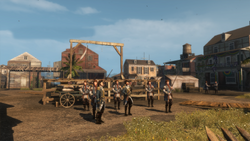
French troops stationed in New Orleans despite Spanish occupation
Roughly a year later, Spain's acquisition of Louisiana was officially announced. The Templar Order used the colony's transfer to gain access to the highest levels of government and extend their operations. Meanwhile, the transition from French colonial control to Spanish occupation left the residents of New Orleans dissatisfied with Spain's weak political authority, as it tried to distance itself from the previous French administrative structures.[1]
This ambiguous and unstable political environment soon enticed the Templars into attempting to take control of New Orleans.[1] In 1765, governor d'Abbadie made a deal with the Templar Rafael Joaquín de Ferrer; d'Abbadie would remain in power, provided he supervised the colony's transfer and supplied de Ferrer with workers for a secret project. However, this scheme was uncovered by the Assassin Aveline de Grandpré, who assassinated the governor during a party held at his mansion.[2]
In 1766, the nobility of New Orleans was targeted by a dissident Assassin from Saint-Domingue named Baptiste, who intended to poison them to help the Templars tighten their grip on the city. This crisis was averted when Baptiste was assassinated by Aveline, putting an end to his plans for New Orleans.[2]
Louisiana Rebellion
- Main article: Louisiana Rebellion
- "How blessed we are with a daughter who uses her talents in peace... not to riot in the streets of New Orleans. There is so much unrest since the arrival of the Spanish..."
- ―Philippe Olivier de Grandpré on the consequences of the Spanish occupation, 1768.[src]
That same year, Antonio de Ulloa, a Templar adviser, arrived in New Orleans to serve as the first Spanish Governor of Louisiana. However, he allowed the French flag to remain over the city, leaving the administration of the territory to French Creole officials while he and his family lived at La Balize, away from New Orleans.[1] In secret, de Ulloa had citizens of low standing kidnapped, sending them to a work camp run by de Ferrer in Chichen Itza, Mexico.[2]
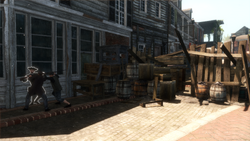
Citizens fighting de Ulloa's soldiers
In 1768, de Ulloa implemented rigid trade restrictions within the colony, which benefited the Templars and allowed their shipment of workers to continue. This caused French Creoles' opinion of him to drop even lower and led them to rebel against the governor's regime. Riots soon grew commonplace, with citizens setting up barricades and openly challenging Spanish soldiers.[2]
The widespread chaos in the city eventually forced de Ulloa to leave his hiding place, so that he could attempt to negotiate for peace. While en route, his envoy was ambushed by Aveline, who had orders to assassinate the governor; however, she ultimately chose to spare him, and forced Ulloa to go into exile. Following his departure, New Orleans was briefly governed by the French Creoles.[2]
Under the approval of the French King, the Spanish commissioned de Ulloa's replacement, General Alejandro O'Reilly to suppress the rebellion and punish those responsible. To prevent any further violence, French Creole leaders urged citizens to avoid military confrontation and accept Spanish authority. In the summer of 1769, O'Reilly arrived in New Orleans without any major interference and executed those that had been at the forefront of the rebellion. He introduced "O'Reilly's Code", which embodied the laws of Castile and of the Indies, thus aligning Louisiana's legal system with that of Spain.[1] In the following years, Spain secured a tighter grip on the colony, but also encouraged free trade and eased the restrictions on the emancipation of slaves.[2]
Elimination of the Templars
- "The Templars will never allow slaves to be free! They keep even the rich in bondage - though most people would never suspect..."
- ―Aveline on the Templars' control over New Orleans, 1768.[src]
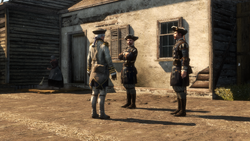
One of Vázquez's recruiters bribing Spanish soldiers
For a while, the city remained free of Templar machinations, but by 1771, a Templar by the name of Diego Vázquez became active in the region, recruiting Spanish soldiers to his cause through bribery. He intended to seize control of the Louisiana Bayou, which was economically important to New Orleans due to its popularity as a smuggling route. Vázquez's progress was temporarily set back by Aveline that same year, but her absence allowed his troops to recover.[2]
Preferring the British be kept away from Spanish territory, the Governor of Louisiana decided to support the American Patriots in 1776 by having the smugglers send them supplies, an arrangement that the Templars opposed. Vázquez subsequently ordered his men to steal the wares from the smugglers at the nearest opportunity, but in this too he failed, as Aveline would once more obstruct his schemes.[2]
Following the assassination of Vázquez that same year, the Templars' power in New Orleans dwindled, though the "Company Man" remained at large. In 1777, Louisiana's head Templar was revealed to be Madeleine de L'Isle, Aveline's stepmother. After being led to believe that Aveline would join the Templars, Madeleine was killed by her stepdaughter in the Saint Louis Cathedral, temporarily removing Templar influence in New Orleans.[2]
Louisiana Purchase
In the decades that followed, several devastating fires ravaged New Orleans, destroying much of the French colonial architecture. In 1801, Spanish rule ended and the city was handed back to the French, though Spain had made a considerable contribution to its expansion. However, French rule ended two years later when Napoleon Bonaparte sold the colony to the United States, a transaction directed by the United States President, Thomas Jefferson.[1]
Layout
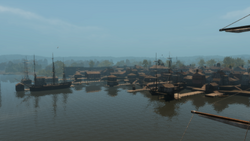
The docks
Enclosed by a palisade wall, the city of New Orleans could be roughly divided into three regions. In the southernmost region lay the docks, populated by rough sailors and tense smugglers. One of New Orleans' most important sources of income, the docks housed numerous warehouses and storage facilities, as well the slave trader's holding area, located in the southwest corner of the city.[2]
The central region was the largest, being home to New Orleans' wealthy and powerful. With the Saint Louis Cathedral as its dominating landmark, the district was a testament to the city's prominent position in trade, being dotted with opulent mansions, trees and lush gardens. Decorative features such as gazebos and balconies, as well as courtyards and markets - the French Market near the docks being the most prominent example - were commonplace. During Mardi Gras, masks, lanterns and colorful fabrics were strung up to give the region a festive air.[2]
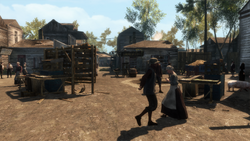
New Orleans' poor district
The northernmost region, largely inhabited by farmers and workers, did not share in the city's wealth, as evidenced by most residences being in a dilapidated state. Animals could sometimes be seen walking around in the streets, which were unpaved and tended to be narrower than those of New Orleans' wealthier neighborhoods. The poor district housed the city graveyard, as well as the military barracks located in the northeast.[2]
A multifarious society, the general populace of New Orleans was varied, with a range of different people inhabiting it. The city's residents were usually, though not exclusively, of French origin, leading them to wear similar styles of clothing; even the servants were often dressed in civilized attire akin to that of their masters, albeit with less vibrant colors.[2]
Notable landmarks in New Orleans included Saint Louis Cathedral, the Place d'Armes, Saint Peter's Cemetery, Congo Square, Madame John's Legacy, the Governor's mansion, the de Grandpré mansion and the de Grandpré warehouse.[2]
Trivia
- Historically, New Orleans' layout during the 18th century would have followed a grid plan, a type of city plan in which streets run at right angles to each other. However, the level designers did not adhere to this structure too strongly as they found it did not accommodate interesting gameplay.[3]
- French soldiers were only found in New Orleans, and the Louisiana Bayou, during Sequences 1 and 2. In later sequences, they were replaced by Spanish guards, as Spain had, by then, started to assert its control over the colony.
- During the short sequence in which Aveline and Gérald escape in a gunpowder carriage, the streets of New Orleans were altered slightly to give the rig more room to move.
Gallery
Appearances
References
| ||||||||||||||||||||||||||||||||||



